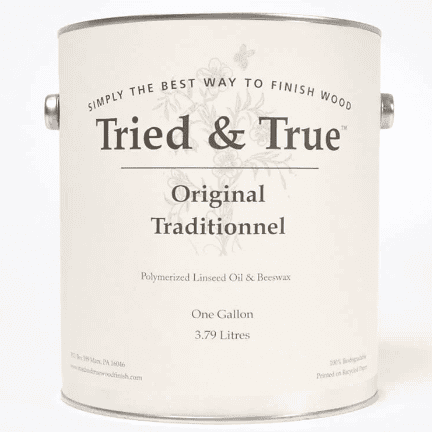Wooden projects like furniture require conditioning to keep them at their best, free from damage. Wood oils are essential for protecting and decorating wooden projects due to their penetrating nature. It can seep into the wooden pores to replace oils that have been lost. There are many reasons woodworkers utilize wood furniture oils, such as protection from UV light radiation, moisture, attack from pests, and a host of others.
Surprisingly oils do not leave extremely shiny surfaces, so they are great to use on uneven surfaces. The ability of oils to re-establish the natural look of the furniture is enormous. It prolongs the furniture’s lifespan while ensuring a unique look. Since wear and tear affects wood and makes it lose its attractiveness with time, it is vital to apply wood oil to maintain its beauty.
If you’re considering wood oils for your furniture, you may encounter some challenges in selecting the right type of oil. We understand this challenge and have taken up the task of reviewing only the best wood furniture oils so you don’t make a selection mistake. However, it’s about more than just the best oil review; we’ve included a buyer’s guide and FAQs section.
Tried and True Original Wood Finish
Our Top Recommendation for Oils to Use for Wood Furniture!
This Tried and True original wood finish would make a fantastic choice. Consider an all-natural, non-toxic, food-safe wood oil that can protect and renew your furniture.
Best Oils to Use For Wood Furniture
What would you consider the best wood furniture oil right now? Before you start to worry, this is why we’re writing this piece, to show you some of the best oils to use on your wooden furniture. So, without further ado, here are our best picks:
| IMAGE | PRODUCT | FEATURES | PRICE |
|---|---|---|---|
 | Tried and True Original Wood Finish | • All natural and non-toxic • Forms a hard layer of protection • Dries to a clear, natural look | |
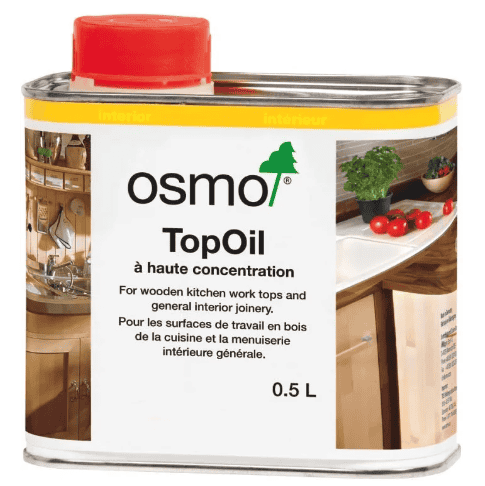 | Osmo Top Oil | • No discoloration • No VOC • Made from natural materials | |
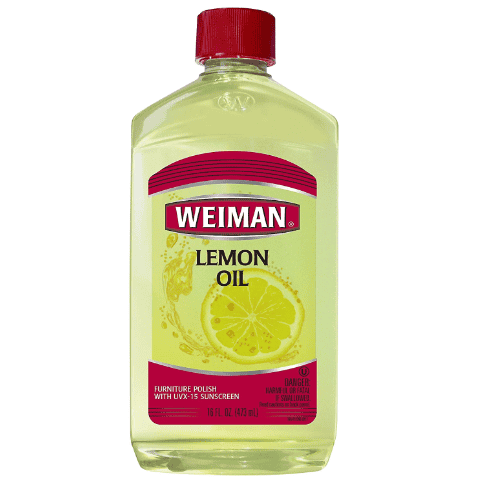 | Weiman Lemon Oil Wood Polish | • Quick application • UVX-15 sunscreen • Pleasant lemon scent | |
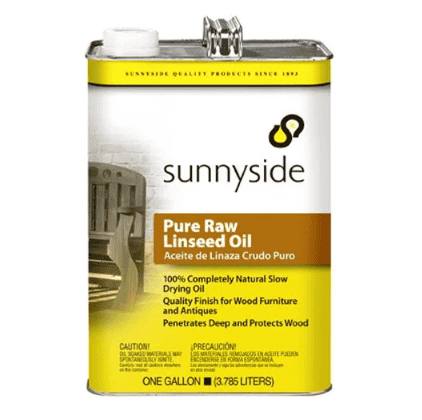 | Sunnyside Corporation 873G1 Pure Raw Linseed Oil | • Deeply penetrates wood • For indoor and outdoor use • High moisture and weather resistance | |
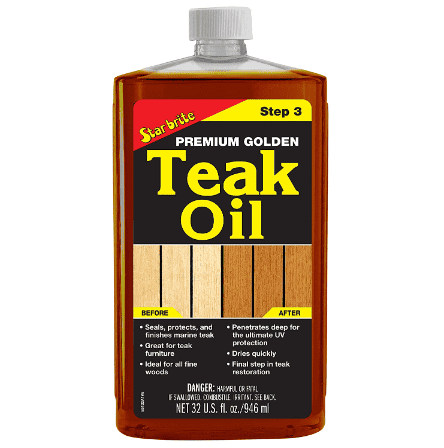 | Star Brite Premium Golden Teak Oil | • Easy to apply and dries fast • UV inhibitors • Longer protection time frame | |
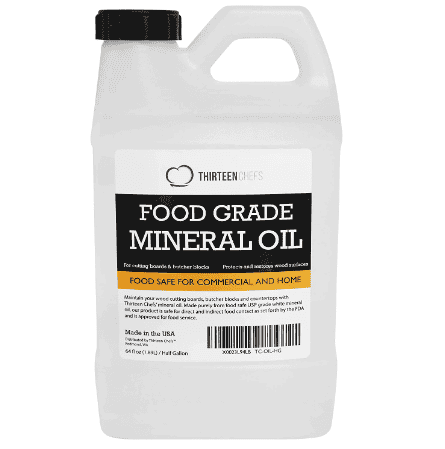 | Thirteen Chefs Food Grade Mineral Oil | • Non-toxic • Food safe • Easy application | |
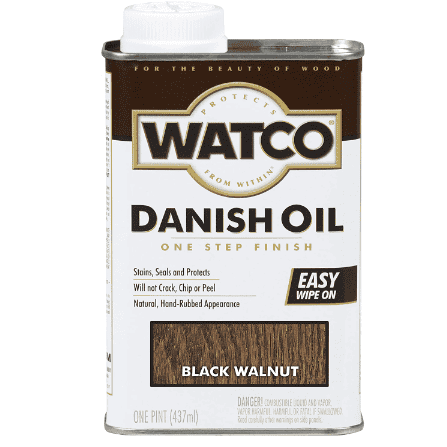 | Watco 65351 Danish Oil Wood Finish | • Produces a warm natural finish • Fast drying • Penetrates deeply | |
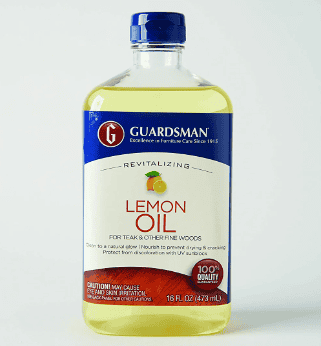 | Guardsman Revitalizing Lemon Oil | • Cleans surface • Restores lost oil • Contains UV blockers |
1. Tried and True Original Wood Finish

The tried and true Original wood finish comes in different sizes from a pint to gallon, with boiled linseed oil base and beeswax forming its major ingredients. The combination forms a thick, viscous liquid that’ll take more effort to work into the grain during application. Using a rag to apply this viscous oil and disposing of the rag properly after use to avoid combustion is an effective strategy. Tried and true is famous for its natural and non-toxic wood finishes.

It has a slow drying process, usually taking up to 24 hours for a coat to dry, and will require several days to coat a few layers. After drying, it leaves a clear, natural finish with an attractive raised grain structure and is suitable for any wood type. The wax and the oil protect the surface from moisture and light physical pressure as parts of the oil remain in the wax that solidifies to form a hard layer for extra protection.
Tired and true finishes take pride in providing non-toxic materials, with this wood finish being non-toxic and 100% natural. It is also food safe, so it can be used on surfaces that come in contact with food and around kids and pets. However, wood oil is expensive so it may be more economical for small projects.

Pros & Cons
Pros
- All natural and non-toxic
- Forms a hard layer of protection
- Protects against water and light physical stress
- Food safe and can be used around kids and pets
- Dries to a clear, natural look
Cons
- Expensive
- Slow drying
- It cannot be easy to apply due to its thick and dense content.
2. Osmo Top Oil

Here is another combination of natural oil and waxes that produces a thick content, but unlike the previous oil, it is easy to apply. However, it’ll require effort to rub the oil into the grain. Osmo Top oil is an excellent water repellent that protects against moisture, stains, and light physical pressure with its food grade quality making it possible to use on surfaces that touch food.
It dries to a clear satin finish that resists scratches and makes it easier to wipe the dirt, oil, and grime off the surface. The good thing about this wood oil is that you can apply it without sanding the surface or removing any previous top oil coat. Even though its resistance to physical pressure is minimal, the partial hardening of the oil on the surface creates a protective barrier against scruffing and scratching. In addition, it is water-resistant and easy to identify when a new coat is needed.

Osmo top oil takes about 12 hours to dry to touch. Still, it may require more than 24 hours to cure completely, presenting a slow drying process that can elongate your application time for several coats. Since the oil does not leave a sheen to its finish, it is great for imperfect surfaces. It is safe to use without gloves and masks since it contains no VOCs and is made from natural materials. Its food-grade quality makes it safe around kids, pets, and on surfaces that touch food. However, it is quite expensive, especially for larger surfaces.
Pros & Cons
Pros
- Water and moisture repellent
- No discoloration of wood
- Food grade quality
- No VOC and non-toxic
- Made from natural materials
- No sheen so suitable for imperfect surfaces
Cons
- Expensive oil
- Poor physical stress resistance
- Slow drying time
3. Weiman Lemon Oil Wood Polish

Using this Weiman lemon oil, you can freshen up old wood and renew faded wooden furniture. Weiman is popular for wood renewal and cleaning products, with this lemon oil product proving popular. It comes in a 16-fluid-ounce size with a lemon scent that makes it quite pleasing. In addition, Weiman lemon oil leaves no sticky residue after shining on your furniture, cabinet, doors, or any other wooden project.

Weiman lemon oil sports an ultraviolet rating of UVX-15 sunscreen that protects the wood from harmful UV rays. These rays can cause dryness, fading, and discoloration. Therefore, Weiman prides itself on using only the purest oils to make the Weiman lemon oil wood finish. To apply this oil, pour some on a clean rag and rub deeply on the furniture before buffing it with another clean cloth, so it shines.
The oil soaks deep into the wood grains to give a lustrous shine that prevents damage and looks exceptional. It is great for a quick clean and protects against watermarks, scratches, and fades.
Pros & Cons
Pros
- Deeply penetrates wood grains
- Great for a variety of different wood types
- UVX-15 sunscreen
- Quick application
- Lemon scent
Cons
- Not food grade, so not suitable for cutting boards
4. Sunnyside Corporation 873G1 Pure Raw Linseed Oil

Linseed oil is extracted from flax seed and is used to preserve lumber and as an ingredient in paint and other finishes. Generally, linseed oil has been used to preserve wood and protect it from deterioration and discoloration. Sunnyside Corporation uses pure raw linseed oil as the major ingredient for its wood oil. It comes with natural wood preservation and enhanced protection caused by adding other ingredients.

Sunnyside, raw linseed oil, can be used indoors and outdoors as it protects wood from the weather, moisture, and normal depreciation over time. In addition, it revitalizes wood using its ability to enhance the natural wood grain and improve wood shine. You can apply this oil to unfinished wood or mix it in oil-based stains and paints to add a layer of protection to your wood that goes deep into the grains.
It sports a mild smell but is safe for cutting boards and other surfaces that come in contact with food. It takes a considerable time to dry, typically up to 4 days, and is suitable for raw wood only.

Pros & Cons
Pros
- Deeply penetrates the wood, offering improved protection
- Indoor and outdoor usage
- High moisture and weather resistance
- It can be mixed with oil-based paint or stains
Cons
- Dries slowly, typically up to 4 days
- Only suitable for raw wood
5. Star Brite Premium Golden Teak Oil

Antique and premium furniture require a more delicate touch, which is what the Star Brite premium golden teak oil promises. It offers the best preservation and protection for fine wood like marine teak. Maximum protection against UV rays is established through the high-tech additives in the oil. The finish contains premium natural oil delicately refined to produce a polymer with high molecular weight so it can withstand any exposure to saltwater and the weather.

Using this oil does not require much effort as it is easy to use by applying it on a cloth and rubbing it generously on the wood surface. In addition, there are so many things this oil can do, including acting as a sealant and top coat. It includes an amber-gold finish, further enhancing the premium furniture it covers.
This teak oil is toxic with many VOCs and combustible, so properly dispose of the rags used to buff and apply the oil. Generally, teak oils lose their effectiveness with time and will require reapplication; however, this Star Brite teak oil offers up to 6 times longer protection for the wood. In addition, the oil is fast drying, so the application time is short.

Pros & Cons
Pros
- Easy to apply and dries fast
- Perfect for antiques and premium furniture
- Longer protection time frame
- UV inhibitors ensure outdoor protection
Cons
- Toxic and flammable
6. Thirteen Chefs Food Grade Mineral Oil

Food-grade mineral oil means you can use it on cutting blocks and other wooden surfaces that come in contact with food with any effect. It is odorless, tasteless, gluten-free, colorless, and meets food safety regulations. In addition, this highly popular wood oil is long-lasting, with a single bottle able to last for years, depending on the size of the surface.

This Thirteen Chefs food-grade mineral oil is safe and non-toxic while rejuvenating aging wood surfaces. It is manufactured with 100% pure food-grade materials in FDA-compliant factories in the US. Applying this food-grade mineral oil can also prevent wood warping, dryness, fading, and fraying of wooden surfaces.
To enjoy its easy-to-use qualities, clean the wood surface to remove dirt and allow it to dry before applying a generous amount of Thirteen Chefs mineral oil. For best results, leave it for about 24 hours to absorb the oil and dry.

Pros & Cons
Pros
- Made with 100% pure food-grade materials
- Non-toxic and food safe
- Easy application
- Prevents cracking, drying, fading, and fraying
Cons
- It may require frequent reapplication
7. Watco 65351 Danish Oil Wood Finish

This Watco danish oil finish comprises blended oil and varnish that deeply penetrates wooden pores to ensure better protection. Its superior protection, even on tight grain woods, is due to its deep penetrating oil that offers protection from within. Sealing and protecting the wood while producing a warm, natural finish are some things to expect from this Danish oil.

The Watco Danish oil in consideration is a black/walnut color that gives this dark but warm look after application. It is suitable for various indoor surfaces, including sanded, bare, and stripped. Furthermore, its fast-drying properties are desirable as it dries to the touch in as little as 6 hours and dries to a rich, warm glow.
You can protect your wooden furniture from chipping, abrasion, spills, peeling, and more by applying the Watco Danish oil. It is easy to apply, affordable, and comes in a pint size.

Pros & Cons
Pros
- Easy to apply oil
- Affordable
- Fast drying
- Deeply penetrates wood grains
- Suitable for sanded, stripped, and bare surfaces
- Produces a warm natural finish
Cons
- Only suitable for indoor use
8. Guardsman Revitalizing Lemon Oil

To rejuvenate dry or warping wood, you need an oil with natural revitalizing qualities like lemon oil. This Guardsman finish uses lemon oil to renew aging wood surfaces. While it is great for dried and unfinished surfaces, it can also be used on solid wood. Guardsman lemon oil is effective because it cleans off dirt and grime from wooden surfaces and clears the pores to access the grains to replace lost oils.

The UV blockers in the oil prevent damage from the sun’s rays, like fading and discoloration. It comes in 16-ounce bottles, which is the perfect size for small projects but may require several bottles to cover a larger surface. Guardsman revitalizing lemon oil sports a pleasant smell, making it unsuitable for cutting boards.
Applying this oil is easy by using the special Guardsman lint-free cloth to wipe the surface. By now, you should have a clean surface and can proceed with the application using a soft cotton cloth and rubbing the oil toward the grain. Finally, allow the oil to dry to reveal a shiny, protected surface.

Pros & Cons
Pros
- Cleans surface
- Restores lost oils
- Versatile application
- Pleasant lemon scent
- Contains UV blockers
Cons
- Lemon oil quickly loses its effect and requires frequent reapplication
- It will require a large order for wider surfaces due to the small 16-ounce size
Types of Wood Oils
There are several types of wood oils with their use cases. Understanding the wood oil types will help you choose the right oil.
1. Wax
Waxes are hard and can’t be rubbed on the surface; as such unsuitable for standalone finishes. They are perfect as additives.
2. Tung oil
Tung oil is from tung trees, hardens on-air exposure, and can protect against physical damage and moisture. Its drying time is extremely long, which is often mixed with chemicals that can hasten the process.
3. Oil And Varnish Blend
This combines oils and varnish to produce water-resistant and physically durable surfaces. They are less safe due to their high VOC content.
4. Mineral Oil
Require reapplication as they have an extremely fast drying time with a good look when it dries.
5. Linseed Oil
Comes with a long drying time but improved durability. Some linseed oils undergo boiling or treatment with chemicals to reduce drying time.
6. Danish Oil
This is a combination of several materials like polymers, hardening chemicals, tung oil, and thinner to form an impressive water-resistant and physically durable surface.
Buyers Guide – Factors to Consider
Buying a wood oil for your furniture may require more than tact since there are several similar oils in the market. You need to understand your needs and the major properties of wood oil to make the correct buying decision. Here, we’ve highlighted factors to consider to select the right wood oil for your furniture.
1. Durability
It would help if you considered the durability of the oil before purchasing. Investing in oil with longer durability will ensure you do not keep reapplying quickly, thereby spending a lot of money and time. Some oils require constant reapplication because they aren’t the most durable. In contrast, others offer a longer period without worrying about applying another coat.
2. Price
The cost of the wood oil may be a huge stumbling block, especially if you’re on a strict budget. Consider the amount you’re willing to spend and filter oils based on this range to make it easier to find wood oils you can afford.
3. Size
Look at the oils’ sizes and determine how many you’ll need to cover your project. Some oils have different sizes up to a gallon. In contrast, others only offer pints or smaller containers which may mean buying several to cover a larger surface. Consider the size of your project and wood oil before purchasing.
FAQ’s
See quick questions people ask about wood oils for furniture and their answers.
Ans: Oils offer deep penetration into wooden pores and, as such, better protection and sealing quality. Oils can also prevent scratching, damage from UV rays, and more.
Ans: While wood oil is not a sealer, it offers some sealing properties that help it prevent moisture from entering the wood.
Ans: Spread the rag flat to ensure speedy drying, or submerge the rag in water in an airtight rag. Since oils with solvents are fire hazards, proper disposal of application materials is essential.
Ans: Yes, wood oil will darken wood from its natural color but will not completely change its color.
Summary
When you decide to renew that fading wood furniture and get overwhelmed with choices on selecting a suitable wood oil, this guide will help you. It goes beyond listing the best oils in the market but also ensures you understand some of the factors that make them the best.


